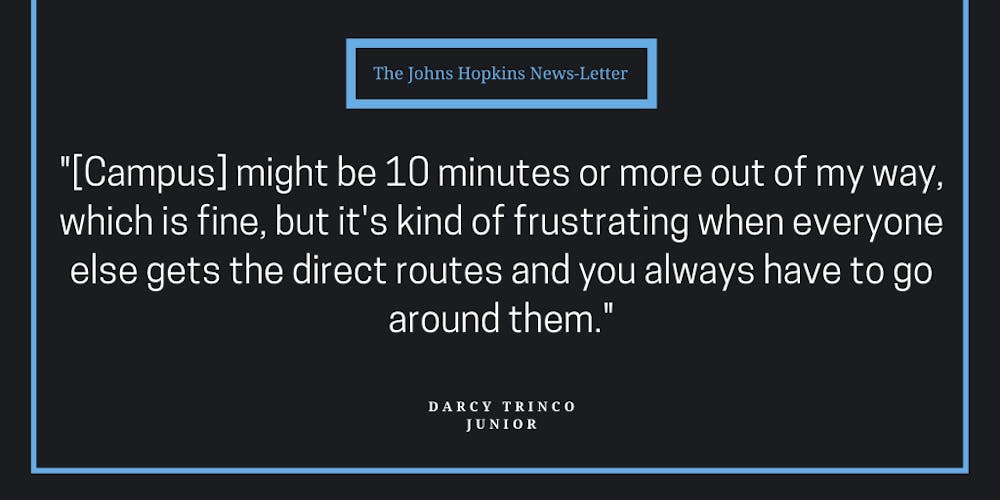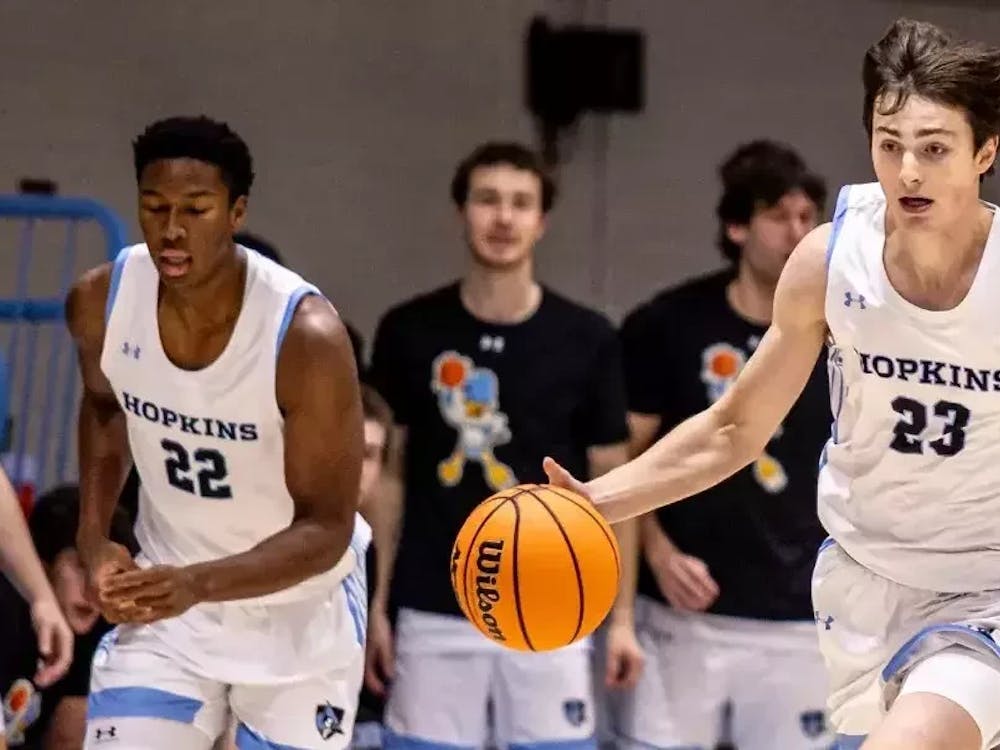Students with disabilities affecting their mobility reported challenges in navigating campus and receiving accommodations in interviews with The News-Letter.
Mattin Center closure
The closure of the Mattin Center entrance to campus blocked off a previously accessible route from N. Charles Street into campus.
Junior Isaac Diaz reflected on the challenges the closure poses in an interview with The News-Letter.
“[The construction] is definitely taking away some of the routes. The Mattin Center was one of the most direct routes when you go off campus,” he said. “Restricting [it] disrupted direct routes.”
Junior Darcy Trinco discussed how the closure poses significant inconveniences to students with disabilities.
“[Campus] might be 10 minutes or more out of my way, which is fine, but it's kind of frustrating when everyone else gets the direct routes and you always have to go around them,” she said. “But that's life, I guess.”
Director of Media Relations Jill Rosen wrote about steps the University has taken to mitigate these challenges in an email to The News-Letter.
“Safe pedestrian paths have been established around all campus construction activity, including the Hopkins Student Center,” she wrote. “All required temporary or permanent pathway adjustments have been coordinated with consultants and university staff to maintain and increase accessibility whenever possible.”
Mobility issues on campus
Advocates for Disability Awareness Treasurer Kate Ketelhohn discussed how paths on campus are often marked as accessible but in reality may not be.
“Campus had marked that the cobblestones throughout campus were accessible routes, which if you've ever been in any sort of mobility device, they really aren't,” she said. “Accessibility isn't just a straight path or a flat path or a path without stairs. It is one that is smooth that won't really hurt you or your assistive devices when you use them.”
Ketelhohn pointed out that projects around campus to increase accessibility could be prioritized over new construction.
“Campus is a very beautiful place. Now, with oldness and beauty comes a lot of stairs — we don't need that many stairs,” she said. “There's some areas that could probably easily just be converted into ramps. Instead of focusing on some other new project, you could take what we have and expand it so there can be more worldwide accessibility.”
Ketelhohn also noted that issues with unclear signage make it difficult for people with disabilities to navigate campus. She cited Remsen Hall as a place where the locations of accessible entrances or paths are often unclear.
Advocates for Disability Awareness President Kai Holton emphasized how the prevalence of stairs and uneven surfaces present issues.
“Looking at the general campus, other than the Milton S. Eisenhower Library entrance at the very, very top of the Beach, everything else is really mostly staircases — or are very, very uneven surfaces and non-accessible ramps,” Holton said.
Rosen reiterated that the University is conducting inspections of paths and signage to ensure access and visibility and that concerns should be addressed to Student Disability Services (SDS).
Housing
Ketelhohn lives on the sixth floor of McCoy Hall to fulfill her accommodations. She highlighted issues with her recent experience during a fire drill in the building.
“We had a fire drill the other week that I was not notified of, so I ended up going up six flights of stairs, which really impacted my physical health for the next two weeks. The day after our fire drill, we got notified what the disability protocol was for a fire drill,” she said. “If you are disabled and there is a fire, you are supposed to wait in your room and call security.”
Rosen noted that the Disability Emergency Evacuation Protocol (DEEP) that the University uses has been developed by SDS, Public Safety and Residential Life to focus on emergency situations in residential buildings and across campus.
Students with disabilities also reported difficulties finding accessible off-campus housing in proximity to Homewood Campus.
Trinco lives on campus as a junior due to difficulties finding accessible housing.
“I had trouble in Baltimore finding accessible housing [with my] power wheelchair,” she said. “[The University] want[s] me to stay on campus in Charles Commons, which is super nice.”
Rosen explained how the University helps students with disabilities find adequate housing.
“The Off Campus Housing staff are knowledgeable about rental properties in the community, especially those commonly used by students,” she wrote. “Student Disability Services can connect students with the office for help locating off-campus apartments that feature accessibility, including features like wheelchair access, close parking and visual alarms.”
Improving inclusivity on campus
Trinco has had difficult experiences working with SDS to fulfill her non-academic needs.
“If you're looking at things beyond the classroom, it gets a little iffy because I think there's a lack of capacity — and also the fact that every student goes in there and needs different things,” she said. “My expectations are very low. When I plan... I also know that a lot of the time it’s about advocating for myself, and it does get kind of exhausting.”
Holton discussed how the Americans with Disabilities Act (ADA) supports advocacy for greater education for staff, faculty and students about the experiences of students with disabilities.
“Staff and faculty training regarding the accommodations is a big one,” he said. “The fact that that's kind of lacking currently in Orientation is something that we have to work on because I think that would be great in terms of having visibility.”
Ketelhohn pointed out how admissions statistics don’t usually incorporate data on the proportion of students with disabilities on campus and how that would help prospective and current students.
“With admission statistics, you always see statistics on certain breakdowns or graduation rates or acceptance rates, and I've never seen any numbers for that regarding the disability community,” she said. “That would be extremely helpful so other disabled students can get an idea of how much the institution will help them.”





